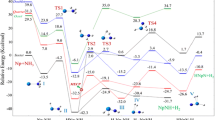Abstract
An analysis of the available experimental data on the slow and explosive decomposition of metal azides demonstrates that the intermediate product of the reaction is N6. Based on quantum-chemical calculations, the most symmetrical stable N6 complexes with cyclic, linear, and previously undetected octahedral configurations are established. The energy balance of reactions is calculated. It is demonstrated that the activation energy of forming the cyclic complex is minimum, and the energy of forming the octahedral complex is maximum. Conditions of forming complexes inside the crystal matrix are discussed. An important role of metal in the formation of complexes from azide groups is demonstrated, in particular, the existence of the stable Me2N6 cluster is established.
Similar content being viewed by others
REFERENCES
F. P. Bowden and A. D. Ioffe, Fast Reactions in Solids, Butterwords Scientific Publications, London (1985).
H. D. Fair and R. F. Walker, Energetic Materials, Vol. 1, Plenum Press, New York (1987).
Yu. A. Zakharov, É. D. Aluker, B. P. Aduev, et al., Pre-explosive Phenomena in Heavy-Metal Azides [in Russian], Khimmash, Moscow (2002).
A. S. Biryukov, E. D. Bulatov, S. A. Gridin, et al., Khim. Fiz., 4, No. 1, 79–88 (1985).
V. Yu. Zakharov, V. I. Krasheninin, E. G. Gazenauér, et al., Izv. Vyssh. Uchebn. Zaved., Fiz., No. 6, 17–21 (2002).
A. Bonnemay and R. Dandel, Compt. Rend., 23, 2300–2302 (1950).
E. Clementi, J. Chem. Phys., 34, No. 3, 1468–969 (1961).
E. Clementi, A. D. McIean, J. Chem. Phys., 39, No. 1, 323–326 (1963).
S. D. Peyerimhoff and R. J. Buenker, J. Chem. Phys., 47, No. 4, 1953–1966 (1967).
J. F. Wyatt, I. H. Hiller, V. R. Saunders, et al., J. Chem. Phys., 54, No. 12, 5311–5315 (1971).
T. W. Archibald and J. R. Sabin, J. Chem. Phys., 55, No. 4, 1821–1829 (1971).
T. Gora and P. J. Kemmey, J. Chem. Phys., 57, No. 8, 3579–3581 (1972).
A. R. Rossi and R. N. Bartram, J. Chem. Phys., 70, No. 1, 532–537 (1979).
U. Kaldor, Int. J. Quant. Chem., 24, 291–294 (1990).
H. Hyber, T. K. Ha, and M. T. Nguyen, J. Mol. Struct., 105, 351–358 (1983).
M. Ramek, J. Mol. Struct., 109, 391 (1984).
M. T. Nguyen, J. Phys. Chem., 94, 6923–6924 (1990).
R. Engelke, Ibid., 6924–6925.
V. Kriger, A. Kalensky, and I. Bulusheva, in: Proc. 11th Int. Conf. Radiative Physics and Chemistry of Condensed Matter [in Russian], Tomsk (2000), pp. 58–60.
M. W. Schmidt, K. K. Baldridge, J. A. Boatz, et al., J. Comput. Chem., 14, 1347–1363 (1993).
Author information
Authors and Affiliations
Rights and permissions
About this article
Cite this article
Aluker, É.D., Zhuravlev, Y.N., Zakharov, V.Y. et al. Modeling of the Elementary Processes of Metal Azide Decomposition. Russian Physics Journal 46, 1057–1061 (2003). https://doi.org/10.1023/B:RUPJ.0000020820.88151.b9
Issue Date:
DOI: https://doi.org/10.1023/B:RUPJ.0000020820.88151.b9




